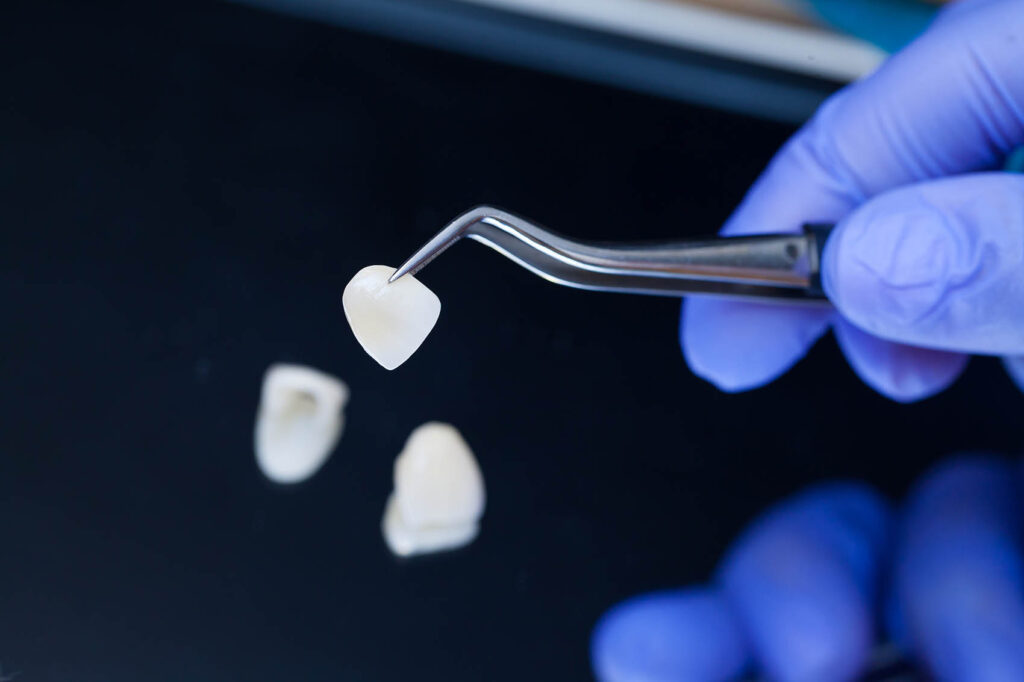The quest for a picture-perfect smile can lead you down many dental avenues, however, veneers tend to emerge as one of the best options to give you that winning shine you can show off with pride. But how exactly do they work and can veneers be placed over existing teeth? The simple answer is yes – they absolutely can. We shed some light on the purpose of veneers and how exactly they work with your existing top and bottom teeth to offer up that million-dollar smile you’ve been searching for.
Understanding the Purpose of Veneers
While you might be on the hunt for veneers to perfect your smile, they actually provide so much more. Porcelain dental veneers serve a dual purpose:
- Aesthetically, they provide you with an immediate smile transformation, fixing a number of dental imperfections ranging from discolouration and staining to minor misalignments and gaps.
- Functionally, they also play a pivotal role in your dental care. Crafted from high-quality porcelain, they act as a robust shield against foods and beverages or the potential wear from daily activities like biting and chewing. Consider them a protective layer that sits over the top.
Recognising that they offer so much more than a cosmetic overlay, their placement requires precision and expertise to ensure that the veneer can perform its job.
Veneers offer a solution for many dental imperfections and might be all that’s standing between you and a smile you love. We will go on to explore some of the main concerns that veneers can address to discover whether they are the right solution for you.
Addressing Alignment and Spacing Issues with Veneers
Dreaming of a straight smile without braces? Who isn’t! Veneers might be just the answer you’re looking for. They can cover up small gaps between your teeth and make slightly crooked teeth appear straight.
If you have a tooth that’s a bit shorter than the others or sits at an angle, veneers can be shaped to cover this imperfection for a radiant smile. At the end of the day, it’s important to remember that veneers are best for minor fixes. If your teeth are very crooked or misshapen, you might need braces first.
Veneers as a Solution for Discoloured or Stained Teeth
Coffee lover? Or maybe red wine is your thing? Over time, our favourite drinks – and sometimes even foods – can stain our teeth without us even realising it before it’s too late. Veneers can cover up these stains, giving you a bright, white smile. They’re custom-made to match your desired shade and look natural to match the rest of your teeth. Whether it’s a surface stain or something deeper, veneers can be designed to give you the best results that fit perfectly for you.
Veneers for Resolving Minor Cosmetic Imperfections
Little chips or slightly uneven teeth are enough to make anyone feel self-conscious. Veneers offer a way to cover up these small imperfections, making your smile look flawless. Whether it’s a chip from that time you accidentally bit into a popcorn kernel or a tooth that’s always been a bit off, veneers can be shaped to give you a perfect smile.
Results of Dental Veneers
Ready to see the transforming results of dental veneers? Head to our before and after page to see exactly how veneers work and what they can achieve for your winning smile. They are a great, permanent solution to your dental imperfections.
Assessing Existing Teeth for Veneer Placement
The first step in achieving your winning smile begins with an assessment of your existing teeth. This will determine the suitability and potential success of veneer placement. It’s about ensuring that the underlying dental structure is ready to support your veneers. As we answered at the beginning of this article, veneers can go over your existing teeth, however, there are certain conditions under which this will work. Here’s what’s involved.
Evaluating the Condition of Existing Teeth
Your dentist will dive beyond the visible surface and look at the condition of your gums, roots, and the surrounding environment. The health of the existing teeth sets the stage for how veneers will perform in the long run.
- The structural integrity of the teeth: are there signs of wear, chipping, or fractures? Such imperfections play a role in determining the approach and techniques used during the veneer placement. A tooth with significant wear, for instance, might need a different preparation compared to one that’s relatively intact.
- The health of the tooth: decay or infections can compromise the success of veneer treatments. Dental professionals will seek to uncover any underlying issues that might sit beneath the surface.
- Gums: healthy gums not only support the teeth but also provide the framework for veneers. Any signs of gum disease or inflammation can impact the longevity and success of veneer treatments.
It’s also important to consider your aesthetic goals. The shape, size, and colour of existing teeth and their alignment are all important when it comes to crafting veneers that not only fit perfectly but also enhance your smile. Dentists use the latest technology, including digital imaging, X-rays and 3D modelling, to get an understanding of your oral situation, allowing them to tailor veneer treatments to your specific needs.
Veneer Compatibility with Different Tooth Conditions
Not all teeth are the same, and veneers need to work for your situation. If your tooth has had a lot of work done, like fillings or root canals, veneers can still be an option, but the approach might change.
Healthy gums are important too, as they help keep veneers in place. If you grind your teeth, this can affect how long veneers last. And if you’re looking to cover up stains, veneers can do that, but the approach might vary based on the type of stain. It’s all about making sure veneers work best for your unique teeth.
Preparing Existing Teeth for Veneers
Investing in veneers isn’t just about adding a new layer to your teeth. First, your dentist will prepare your tooth, ensuring the veneer fits just right. Here’s what’s involved:
- Reshaping of the tooth’s surface
This is about creating an environment for the veneer to bond seamlessly. By gently removing a tiny layer of the enamel, dental professionals ensure that the veneer, when placed, aligns perfectly.
This isn’t a one-size-fits-all approach. The extent of enamel removal is tailored to your individual needs and the requirements of the veneer. Factors such as the initial position of the tooth, its size, and the desired outcome of the veneer treatment all play a role in determining this.
- Cleaning
The tooth’s surface undergoes a thorough cleaning process. This is crucial in ensuring that the bonding agent, which secures the veneer to the tooth, works properly. Any remnants of plaque, tartar, or debris can compromise this bond.
Modern tools and techniques make this process comfortable and precise, ensuring you get the best results. Are you wondering do veneers fall off easily? This process outlined above shows just how much expertise and precision goes into creating and bonding veneers to your existing teeth, making it extremely unlikely for them to ever fall off.
Can Veneers Go Over Existing Teeth
As we have outlined above, veneers can go over existing teeth. How this is achieved comes down to your overall oral health and your individual circumstances. The first step for your experienced dentist is working out whether veneers are an option for your situation. The next step is tailoring their placement to your specific needs so they bond successfully over the top of your tooth.
Book a Veneers Consult
Considering a transformative smile with veneers? Starts with a comprehensive consultation at the Dental and Skin Clinic, where we combine advanced diagnostics with personalised care to understand your dental needs and aesthetic desires. This session demystifies the veneer process, ensuring you make an informed and confident decision. Join us, and let’s craft that perfect smile together.



